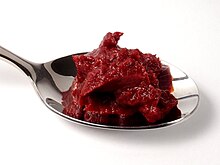
Tomato paste is a thick paste made from tomatoes, which are cooked for several hours to reduce water content, straining out seeds and skins, and cooking the liquid again to reduce the base to a thick, rich concentrate. It is used to impart an intense tomato flavour to a variety of dishes, such as pasta, soups and braised meat. It is used as an ingredient in many world cuisines.
By contrast, tomato purée is a liquid with a thinner consistency than tomato paste, while tomato sauce is even thinner in consistency.
History and traditions
Tomato paste is a traditional food ingredient used in many cuisines. One traditional practice was applied by spreading out a much-reduced tomato sauce on wooden boards that were set outdoors under the hot sun to dry the paste until it was thick enough, when it was scraped up and held together in a dense mass. Commercial production uses tomatoes with thick pericarp walls and lower overall moisture.
Regional differences
In the UK, tomato paste is also referred to as concentrate. In the US, tomato paste is simply concentrated tomato solids (no seeds or skin), sometimes with added sweetener (high fructose corn syrup), and with a standard of identity (in the Code of Federal Regulations, see 21 CFR 155.191). Tomato purée has a lower tomato soluble solids requirement, the cutoff being 24%. For comparison, typical fresh round tomatoes have a soluble solid content of 3.5–5.5% (refractometric Brix), while cherry tomatoes have double the amount.
Uses
Tomato paste is added to dishes to impart an intense flavour, particularly the natural umami flavour found in tomatoes. Examples of dishes in which tomato paste may be commonly used include pasta sauces, soups, and braised meat. The paste is typically added early in the cooking process and sautéed to achieve caramelization.
Based on the manufacturing conditions, the paste can be the basis for making ketchup or reconstituted tomato juice:
- Hot break: heated to about 100 °C (212 °F), pectin is preserved, paste is thicker and can be used for ketchup
- Warm break: heated to about 79 °C (174 °F), colour is not preserved, but flavour is preserved
- Cold break: heated to about 66 °C (151 °F), colour and flavour are preserved, so it can be reconstituted into juice
See also
References
- Kimberley Willis, Viktor Budnik Knack Canning, Pickling & Preserving: Tools, Techniques & Recipes 2010 Page 88 "Tomato paste - Good tomato paste is a kitchen staple. All tomatoes can be cooked down to paste, but starting with paste-type tomatoes, often called Roma tomatoes, will make a faster, smoother product. Juicy tomatoes may take twice as long ..."
- Barbara Ann Kipfer The Culinarian: A Kitchen Desk Reference 2012 - Page 561 "Tomato paste is concentrate of puréed tomatoes sold in cans or at double strength in tubes. ... The differences between tomato paste, tomato purée, and tomato sauce are texture and depth of flavor (the thicker the consistency, the deeper ..."
- Larousse Gastronomique: The World's Greatest Culinary Encyclopedia. Clarkson Potter. 2001.
- Lyn Rutherford, Patrick McLeavey - The Book of Antipasti - Page 8, 1992: "Sun-dried tomato paste — with a richer flavor than ordinary tomato paste, sun-dried tomato paste is a really useful cupboard ingredient."
- Bill Pritchard, David Burch Agri-Food Globalization in Perspective 2003 - Page 183: "Northern Italy is potentially vulnerable to the restructuring of pan-European supply chains because its key output, industrial grade tomato paste, is a standard product readily substitutable from a number of production areas."
- Kilcast, David, ed. (2004). Texture in food (1st published. ed.). Cambridge: Woodhead Pub. ISBN 1855737248.
- "Managing Tomato Taste". Yara United States. 7 March 2018. Archived from the original on 20 September 2022. Retrieved 17 September 2022.
- Delany, Alex (22 February 2018). "Give Tomato Paste the Respect It Deserves". Bon Appétit. Archived from the original on 2020-08-17. Retrieved 2020-08-06.